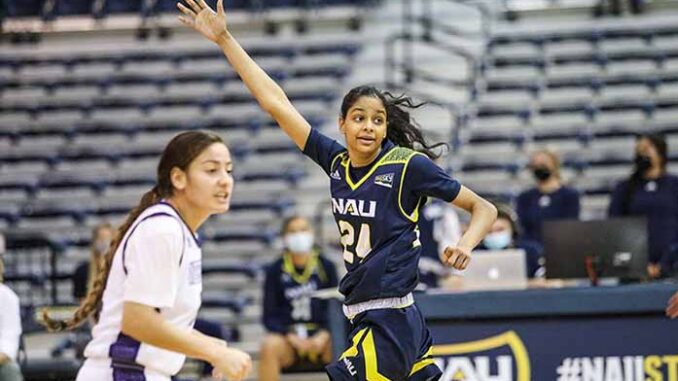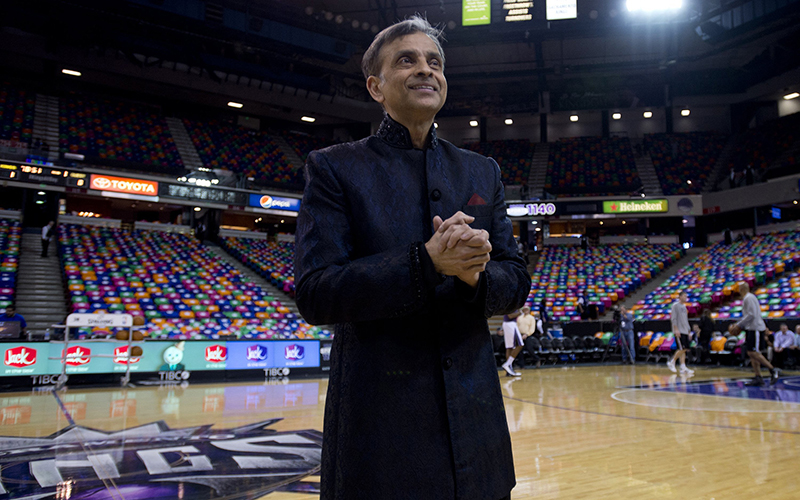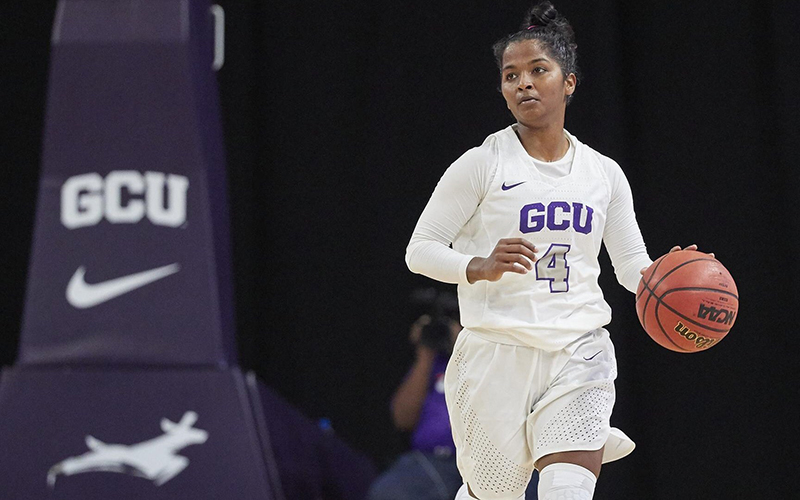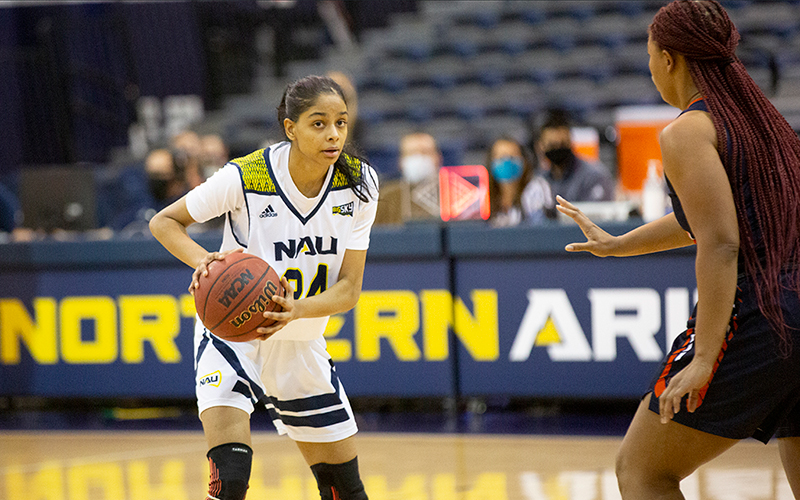
FLAGSTAFF – The Northern Arizona women’s basketball team was in Cheney, Washington, early in the 2020-21 season when coach Loree Payne looked down her bench at sophomore forward Sanjana Ramesh late in the first quarter.
Ramesh had appeared in only five games for the Lumberjacks to that point, but she had not yet scored. As only the second woman from India to receive an NCAA Division I basketball scholarship, she felt a responsibility.
“I was talking to my manager, Peyton (Kohnke),” Ramesh said. “I was like, ‘Peyton, I’m going to cry if I score my first point. I’m going to try to look all cool, but I might just tear up a little bit.’ Because I’ve wanted that for so long.”
She capitalized on the moment, hitting two free throws against Eastern Washington and marking her arrival as a college basketball player. It also gave her a small place in history as the first college player born in India to score points by her sophomore season.
“It was great,” Payne said. “I think anytime you have a kid who is transitioning from high school to college, or in her case from a different country into Division I athletics, you love to see them succeed and to be able to accomplish what they set out to accomplish.”
While a reserve player’s first points might seem to be a small thing in the U.S., it was a significant moment for basketball in India.
“I think what it goes back to with sports is, sports transcend anything – culture, religion, you name it – and we’ve heard it a million times, but sports truly bring people together for a common purpose,” said Blair Hardiek, chief marketing and communications officer for the WNBA Las Vegas Aces, a former global director for the NBA who helped start the women’s program at NBA Academy India.
Ramesh is one of three women from India to secure Division I scholarships and two of them landed in Arizona. The first, Kavita Akula, played at Grand Canyon University from 2017-19 after spending her first two years at Garden City Community College in Kansas. The latest to come to the U.S. is Harsimran Kaur, a 6-foot-4 freshman at the University of San Diego.

Sacramento Kings owner Vivek Ranadive told Bleacher Report in 2014 that the popularity of basketball in his home country will continue to grow because of India’s “cultural appetite for sports entertainment and our pop-culture appeal.” (Jose Luis Villegas/Sacramento Bee/Tribune News Service via Getty Images)
Deep roots
Nearly two centuries ago, basketball made its way to India, thanks to a missionary from the Young Men’s Christian Association (YMCA). In the 1890s, Thomas Duncan Patton introduced the game of hoops to locals during his two years in India as the Acting General Secretary for the Calcutta YMCA.
However, basketball didn’t start gaining popularity until the first national championships were held in 1934. Two years later, both the India men’s and women’s national teams joined the International Basketball Federation, more commonly known as FIBA.
The men’s team played in their first international event in 1951 when they finished fourth overall as hosts of the Asian Games in New Delhi. India made its first appearance in the FIBA Asia Cup in 1965, but the team’s best outing came10 years later after securing a fourth-place finish in Bangkok, Thailand. India then made history in 1980 when the men’s basketball team finished 12th in their first and only appearance in the Olympic Games.
The women’s team made their international debut at the 1970 FIBA Asia Cup in Kuala Lumpur, Malaysia. Their best finish came in 2013 when they ended fifth at the Asia Cup in Bangkok, and India’s most recent appearance was at the 2021 FIBA Asia Cup in Amman, Jordan, where it finished in eighth place.
Despite the history, basketball started making an even bigger impact in India when the NBA formed a broadcast deal to provide unrestricted coverage of the league’s games in the South Asia country in 2012. A year later, Vivek Ranadive bought the Sacramento Kings to make him the first NBA owner from India. Ranadive told Bleacher Report in 2014 that the popularity of basketball in his home country will continue to grow because of India’s “cultural appetite for sports entertainment and our pop-culture appeal.”
Another reason for basketball’s rapid growth in the world’s second-largest country by population is because of India’s younger demographic. Last year, The Ringer reported that the Jr. NBA program in India has outstretched its hands to 11 million youth nationwide. In addition, The Times of India reported in 2018 that 46.9% of India’s population was 25 or younger, according to a Sample Registration System report done by the registrar general and census commissioner of India at the time.
Yannick Colaco, who spent six years as the managing director of NBA Academy India, told Bleacher Report four years earlier that the drastic shift in the younger Indian demographic has contributed to them wanting a new version of cricket, called T20. Colaco added that T20 and the rise of basketball in India are connected.
“They essentially want fast-paced, attractively packaged and competitive sports played in a short time period, which is like basketball,” he said. “T20 is much more on TV and more viewer-friendly than other cricket formats. If you look at how they have gravitated towards T20, the demand from Indian consumers is not dissimilar to that of other sports markets in the world. With basketball among the youth, the growth and participation has been tremendous.”
With the increasing popularity and participation of basketball in India, Ranadive knew his home country could be a breeding ground for NBA talent.
“I believe the merits of basketball speak for itself, but as the country gets more entrenched with the game, you’ll see more and more prospects come through the pipeline,” he told Bleacher Report. “It happened in China and will happen in India. If we continue to invest, I have no doubt that we’ll see a major star emerge from India.”
Eventually, that pipeline was built.

Kavita Akula is the first Indian-born basketball player to receive a Division I scholarship. Akula played at Grand Canyon University in Phoenix from 2017-19 after starting her collegiate career at a community college in Kansas. (Photo courtesy of GCU Athletics)
From Bangalore to Flagstaff
For Sanjana, the journey to Flagstaff seemed almost impossible because of where it started.
Ramesh was born and raised just over 9,000 miles across the globe in the city of Bangalore, the capital of the state of Karnataka in southern India where cricket is king. She got involved in sports as a teenager. Her brother, Savithran, was a big fan of soccer and badminton, two more of India’s most popular sports. He wanted Sanjana to try out for a school team.
But Sanjana fell in love with another sport. One that, Kempa Govindaraj, the president of the Basketball Federation of India, and others believe is the fastest growing in the world’s second-most populated country – basketball.
Ramesh said she looked up to Los Angeles Lakers superstar LeBron James.
“We would wake up at like 6 in the morning just to watch (NBA) games, and it was really fun,” Ramesh said. “Watching (LeBron) lead his team, I wanted to be just like him, just be a leader on the court.”
In May of 2017, the NBA opened the doors of NBA Academy India, a basketball training facility at Jaypee Greens Integrated Sports Complex in Delhi National Capital Region. More than 20 elite male and female players, ages 6-18, receive scholarships to play at the NBA Academy every year, and Ramesh was one of those given this opportunity.
Before attending the NBA India camp, Ramesh knew that she wanted to play basketball in the U.S. She got the idea after reading a newspaper article about Akula, the first Indian-born basketball player to receive a Division I scholarship, who went on to GCU.
“I was like, ‘Wow, this is amazing. I want to try something like this,’” Ramesh said.
When she told her parents of her aspirations of playing NCAA college basketball, they laughed at Sanjana, saying, “that’s not possible” and “to pass 10th grade” first. After all, doing well in the classroom means everything to many in India. For students and their parents, receiving a quality education is at the forefront when looking at colleges.
“Ten times out of 10 when I’d ask players from India, what they want first is education. ‘I want to go to a school where I can get a great education,’” Hardiek said. “As soon as you explain the value of the education (in the U.S.), and then it’s not just about the four years that they’re playing basketball. It’s about using their education as a springboard for life, for career and for excellence, (the parents) were on board right away.”

Ramesh has always been a big basketball fan and said when she was young, she would “wake up at like 6 in the morning just to watch (NBA) games, and it was really fun.” (Photo courtesy of NAU Athletics)
Changing minds
Ramesh said that her parents’ initial reaction motivated her to prove them wrong. In May of 2018, Ramesh was named co-MVP of the very first camp of the NBA Academy India Women’s Program and MVP of the Basketball Without Borders Asia camp later that year.
“Sanjana is one of those people that exudes excellence in everything she does. Whether we were on the court going over plays or off court doing a life-skill session, she’s always paying attention,” Hardiek said. “Every time that I’ve been on the court with her, she’s the type of player (where) it’s not ever about her. She wants to maximize the players that (are) around her and wants to win at the highest level.”
While participating in these elite camps, Ramesh made highlight videos so Hardiek could send them to colleges in the United States. Soon after, a number of programs expressed their interest.
“It was 1 a.m., and I kept getting emails and these Instagram messages,” she said. “I’m like, ‘What’s happening? So many colleges are reaching out!’ It was a really fun experience.”
One of those universities that reached out to Ramesh was located thousands of miles away in the southwestern part of the U.S. – Northern Arizona. Because of the distance, Payne said she wasn’t able to watch Sanjana play in person.
“She didn’t get to come and visit, but we just had some really great conversations,” Payne said. And it was a great opportunity, I think, for her to come to the (United) States to play and for us to really extend our recruiting to an international stage.”
Despite never visiting the campus in Flagstaff and never meeting Payne in person, Ramesh signed with the Lumberjacks when she was 17, mainly because NAU was the only school who stayed committed to Sanjana even after she suffered a “devastating” injury while competing for India’s national team.
The women’s team had traveled to Taiwan for an invitational tournament for the Williams Jones Cup. Ramesh said she was “excited” because this was the first international tournament outside of India she played in, but that thrill would soon be dulled. India was facing New Zealand on the first day of the tournament, and Ramesh entered the game during the first quarter. A couple of plays later, she felt her knee twist awkwardly, tearing her ACL.
“I was so devastated because this is the best tournament to play (in) and (get) my time to shine,” Ramesh said. “Watching my teammates play while I was in my bed just watching, it was really hard, but I was supportive. And I knew that at this point my direction had changed, and I needed to focus on rehab.”
After a painstaking nine-plus months of rehab, Ramesh found herself back on the basketball court.The long and grueling recovery process drained her emotionally and mentally.
“Rehab in India is so much different than rehab (in the U.S.),” she said. “Here, (there) is progress. They have these timelines and what you are supposed to do and how you’re supposed to do it, and there are people always helping you. But in India, the first month you get help. They tell you the exercises you are supposed to do. Then you’re on your own, (and) you have to figure it out.”
Despite the serious injury, NAU had already offered a scholarship to Ramesh and knew that an ACL tear wasn’t going to be a “career changer” for the talented Indian prospect.
“Her ability to rehab, her commitment to rehab and her ability to heal from an injury was something that I think gave us good encouragement,” Payne said. “So just going through that (recovery) process, being along with her through that process was I think something that probably even built our relationship stronger.”
A different world
When Sanjana moved from India to Arizona and started living in her college dorm on NAU’s campus, she couldn’t be more excited. But reality quickly set in for the then-18-year-old freshman. Ramesh was now responsible for all of the cleaning, cooking and other chores that needed to be taken care of on a daily basis. She noted that the biggest adjustment for her was learning how to live on her own.
“It was really hard and figuring things out on my own and like realizing that, hey, your dad is not going to be there to teach you anymore if you’re not doing well in school,” Ramesh said. “You need to figure it out. You need to ask for help. You need to find tutors at your campus to figure it out, so it was a tough process.”
Similarly, the 6-foot wing started lifting weights for the first time when she joined the Lumberjacks, something that Ramesh said was not really emphasized in India.
“When (Sanjana) got here, it was really starting from scratch,” Payne said. “But we’ve seen her slowly progress to add more strength, and that’s kind of the biggest thing right now as she continues to gain strength as kind of that four or five spot for us. … But she’s made some really great progress, and we’re just continuing to work on that progress.”
In three seasons at NAU, Ramesh has appeared in 22 games while averaging just under four minutes per game. Even with limited playing time, her legacy as a scholarship player from India is already written. Ramesh said the accolades mean a lot to her, but they come with a burden.
“I do feel a lot of weight on my shoulders, actually, because the whole country is supporting me. And I don’t want to disappoint people,” Ramesh said. “Just thinking through all that with the pressure on my back, it’s really hard. But I think that it’s a good (thing) because it motivates me for everything I’ve got every single day.”
Sanjana doesn’t want the pressure to stop others from pursuing the same dream of playing basketball in the U.S.
“I want people to not be scared and take that first step because when they do, more people follow,” Ramesh said.
Kaur from the University of San Diego did just that and was the first to score points as a freshman. Kaur, also known as “Honey,” reached out to Ramesh, who guided the younger prospect through the process of applying to colleges while at NBA Academy India. Kaur is one of many players from India that Ramesh has mentored.
Along with college admissions, Hardiek said that Sanjana helped others at the academy through the financial process and by convincing parents that it’s OK if their children leave India for the U.S. to play basketball.
“They wouldn’t be here without her,” Hardiek said. “I can help every way possible, but for them to see that she’s kind of their see-it-be-it person. … She just was a proven measure that if you want to do that, you can do it. And she stood behind them and completely helped give them confidence to come to the United States.”
Setting the stage
Undoubtedly, Sanjana is paving the way for future generations of players to come from India, and she wants them to know that this is possible.
“I just want to show that this is an option for people to come here from any background,” Ramesh said. “You can come from anywhere, and you can achieve your goals. You just put in the hard work. I want to try to get Indian basketball close to American basketball and teach people what I’ve learned and how the system works here.”
The sophomore forward continues working toward her ultimate goal of playing in the WNBA. If that happens, she would be the first from her country to do so in the league’s 26-year history. On the men’s side, India has had a little more success but is still waiting to make its mark.
After not being selected in the 2014 NBA Draft, Sim Bhullar later became the first Indian-born player to see NBA action when he made his debut for the Sacramento Kings in 2015. Just a day later, he scored his first points against the Utah Jazz, making Bhullar the only one from his country to do so. At the end of his 10-day contract, Sacramento declined to re-sign the 7-3 center. Bhullar now plays overseas in Taiwan’s P. League+ as a member of the Hsinchu JKO Lioneers.
Satnam Singh made history of his own when the Dallas Mavericks selected him in the second round of the 2015 NBA Draft. This made Singh the first Indian player drafted in the NBA. However, he never got the chance to play in the league. The IMG Academy alum spent time with the Texas Legends, the Mavericks’ G-League affiliate, for two years and appeared for Dallas in the NBA Summer League in 2015 and ‘17. Singh also starred in the Netflix documentary “One in a Billion,” which followed his path from India to the NBA. In 2021, he decided to switch careers. Singh signed with All Elite Wrestling (AEW) last September, as he awaits his opportunity in professional wrestling.
Milestone matters. Ramesh’s remembers her first two points in that game against Eastern Washington, when she finished with four points, one assist, one rebound, a block and a steal in 11 minutes during NAU’s victory over Eastern Washington 89-60.
After the game, Ramesh said her mother contacted her to congratulate her. Sanjana added that her mother loves basketball and watching it.
“She kind of knew stuff that I didn’t know that I did (during the game),” Ramesh said. “When I told (my parents), they were super happy about it.
“They were like, ‘It’s starting … keep going and see how far you go.’”
That’s exactly what she’s doing.


